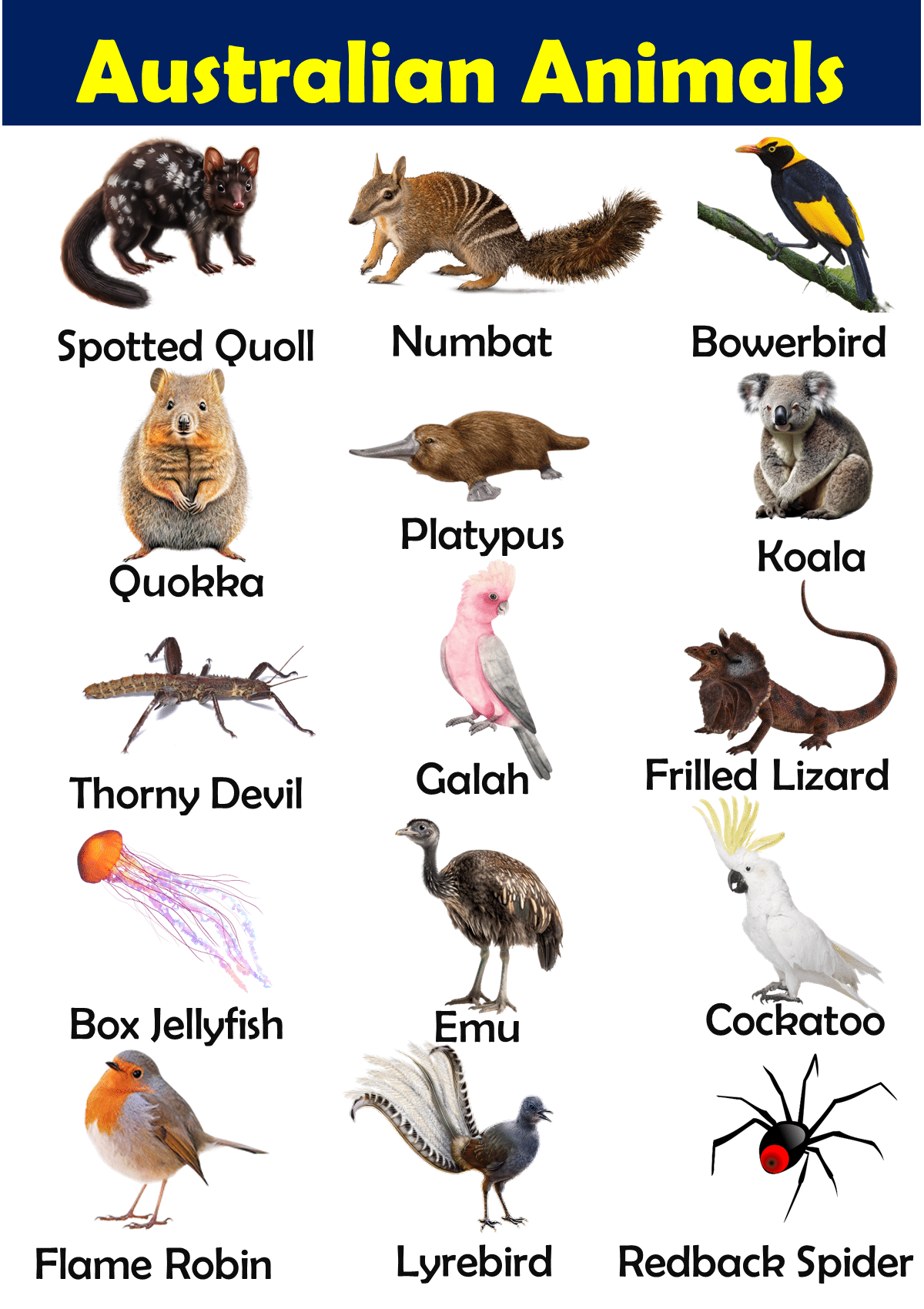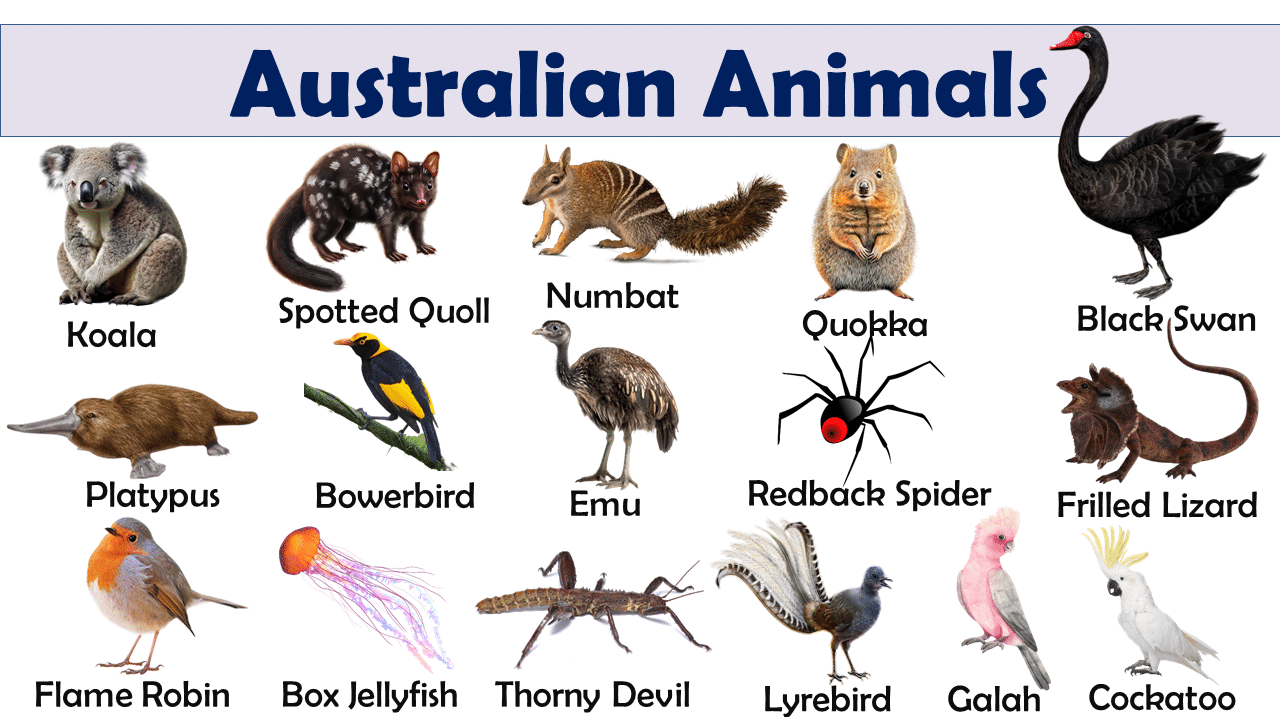Australia is a special place, known for its unique and fascinating wildlife. This blog post will explore some of the amazing animals that call Australia home. From the bouncing kangaroo to the shy platypus, Australian animals are unlike those found anywhere else in the world. Learning about these creatures will not only introduce you to new vocabulary but also give you a glimpse into the diverse ecosystems of Australia. Let’s dive into the world of Australian animals and discover some interesting facts about them!
What are Australian Animals?
Australia is renowned for its unique and diverse wildlife, much of which is found nowhere else on Earth. This is due to the continent’s long geographic isolation. Australian animals include a variety of marsupials, such as kangaroos and koalas, as well as a multitude of reptiles, birds, and marine species. The variety and uniqueness of Australian wildlife make it a point of interest for biologists and nature lovers alike.
List of Australian Animals
- Kangaroo
- Koala
- Platypus
- Echidna
- Wombat
- Tasmanian Devil
- Emu
- Kookaburra
- Dingo
- Quokka
- Cockatoo
- Galah
- Wallaby
- Tasmanian Tiger (extinct)
- Australian Magpie
- Frilled Lizard
- Saltwater Crocodile
- Cassowary
- Australian Fur Seal
- Lyrebird
- Thorny Devil
- Sulfur-crested Cockatoo
- Flying Fox (Fruit Bat)
- Coral Trout
- Redback Spider
- Blue-ringed Octopus
- Bandicoot
- Bilby
- Numbat
- Rainbow Lorikeet
- Bowerbird
- Australian Cattle Dog
- Great White Shark
- Box Jellyfish
- Green Tree Frog
- Moreton Bay Bug
- Blue-tongue Skink
- Mud Crab
- Black Swan
- Sugar Glider
- Australian Pelican
- Manta Ray
- Tawny Frogmouth
- Eastern Brown Snake
- Spotted Quoll
- Lace Monitor
- Australian Brush Turkey
- Leadbeater’s Possum
- Gouldian Finch
- Weedy Sea Dragon
- Murray Cod
- Australian Giant Cuttlefish
- Wedge-tailed Eagle
- Eastern Water Dragon
- Red Kangaroo
- Palm Cockatoo
- Common Wombat
- Red-eyed Tree Frog
- Fairy Penguin (Little Penguin)
- Humpback Whale
- Spiny Anteater
- Loggerhead Turtle
- Yellow-tailed Black Cockatoo
- Antechinus
- Great Barrier Reef Anemone Fish
- Flame Robin
- Saltwater Barramundi
- Australian Sea Lion
- Tiger Snake
- Honeyeater
Explore More Animal Vocab:
Asian Animals | African Animals | American Animals

Australian Animals Vocabulary and Their Facts
1. Kangaroo
Kangaroos are iconic symbols of Australia, characterized by their powerful hind legs and large, muscular tails which assist in balance while hopping. These marsupials are capable of reaching speeds up to 60 km/h. They are social animals, forming groups known as mobs, which provide protection against predators.
2. Koala
Koalas are arboreal marsupials noted for their exclusive diet of eucalyptus leaves, which are toxic to many species but provide koalas with all their nutritional needs. They spend most of their time in trees and are known for their high sleep requirement—up to 20 hours a day—due to the low energy content of their diet.
3. Platypus
The platypus is one of the few monotremes, or egg-laying mammals, featuring a distinctive bill that resembles a duck’s, webbed feet, and a beaver-like tail. Uniquely, the male platypus has a venomous spur on its hind foot, making it one of the few venomous mammals.
4. Echidna
Echidnas, also known as spiny anteaters, are covered with coarse hair and spines. Like the platypus, they are egg-laying mammals and use their long, sticky tongues to feed on ants and termites. Echidnas are solitary animals and are known to burrow into the ground when threatened.
5. Wombat
Wombats are sturdy burrowing marsupials with short, muscular legs. They are known for their backward-facing pouch that prevents dirt and debris from entering while they dig. Wombats produce cube-shaped feces, which they use to mark their territory and prevent their scent markers from rolling away.
6. Tasmanian Devil
The Tasmanian Devil is a carnivorous marsupial known for its robust build, ferocious appetite, and incredibly loud and disturbing screech. It is the largest carnivorous marsupial in the world since the extinction of the Tasmanian tiger. Devils are primarily scavengers, consuming everything from insects to small mammals and carrion.
7. Emu
The emu is Australia’s largest native bird and the second-largest bird in the world by height, after the ostrich. Emus are flightless and have long, powerful legs capable of swift running and formidable kicks. Their diet consists mainly of plants and insects.
8. Kookaburra
Kookaburras are terrestrial tree kingfishers native to Australia and New Guinea, known for their human-like laugh. These birds hunt small animals and insects and are often seen perched waiting for prey. Their distinctive call is said to signal the dawning and ending of the day.
9. Dingo
Dingoes are wild dogs primarily found in Australia’s outback. They are considered apex predators and play a crucial role in the natural ecosystem by controlling populations of other species. Dingoes are versatile hunters but are under threat from habitat loss, persecution, and interbreeding with domestic dogs.
10. Quokka
Quokkas are small marsupials with a happy, smiling appearance that has made them popular on social media. Found mainly on Rottnest Island near Perth, these animals are very approachable but are vulnerable due to their limited distribution and the threats from introduced predators like foxes and cats.
11. Cockatoo
Cockatoos are parrots with a distinctive crest and curved bill. Their social behavior and intelligence make them popular pets, although this has also led to issues with illegal trapping for the pet trade. Cockatoos can live for 50 to 70 years, making them long-term companions.
12. Galah
The Galah, also known as the pink and grey cockatoo, is common across Australian grasslands and is known for its distinctive pink and grey plumage. These birds are highly social and often seen in large flocks, which can be very noisy.
13. Wallaby
Wallabies are like small kangaroos and are adapted to forested and rocky environments where their agility provides protection through mobility. They feed on a variety of plants and have similar social structures to kangaroos.
14. Tasmanian Tiger (Extinct)
The Tasmanian Tiger, or thylacine, was a carnivorous marsupial native to Australia, Tasmania, and New Guinea, and went extinct in the 20th century. It was the largest known carnivorous marsupial of modern times and is a classic example of convergent evolution, resembling a large dog with striped fur.
15. Australian Magpie
The Australian Magpie is a medium-sized black and white bird known for its complex vocalizations and aggressive protection of its territory during the breeding season. It is one of Australia’s most recognized and beloved birds, known for walking along the ground searching for insects and small vertebrates.
16. Frilled Lizard
The frilled lizard is famous for its dramatic display of an open frill around its neck, which it uses to deter predators and during courtship displays. This reptile is arboreal, spending most of its time in trees, and feeds on insects and small vertebrates.
17. Saltwater Crocodile
The saltwater crocodile is the world’s largest living reptile, found in suitable habitats throughout Southeast Asia and northern Australia. These formidable predators are capable of taking almost any animal that enters their territory, including humans.
18. Cassowary
Cassowaries are among the largest and most dangerous birds in the world, known for their striking blue and black plumage and helmet-like casques. Found in the tropical forests of New Guinea and northern Australia, they can be extremely aggressive when threatened and are capable of inflicting serious injuries with their powerful legs and sharp claws.
19. Australian Fur Seal
The Australian fur seal is found on the southern coasts of Australia and is the largest of all fur seals. They have a thick coat and a robust body, and are excellent swimmers. Their diet consists primarily of fish, squid, and octopus.
20. Lyrebird
Lyrebirds are ground-dwelling birds, named for the shape of their tail when fanned out during courtship displays. Known for their incredible ability to mimic natural and artificial sounds from their environment, lyrebirds are among the most exceptional vocal mimics in the bird world.
21. Thorny Devil
The thorny devil is a small lizard known for its unique defense mechanism of having a body covered with sharp spines. It is native to the arid Australian desert and has the ability to change color to blend into its environment. It feeds primarily on ants.
22. Sulfur-crested Cockatoo
This large white cockatoo is famous for its striking sulfur-yellow crest and raucous calls. It is common in wooded areas of Australia and New Guinea and can live for more than 70 years in captivity. These birds are highly intelligent, social, and require complex mental and physical stimulation.
23. Flying Fox (Fruit Bat)
The flying fox, or fruit bat, is the largest bat species in Australia, known for its crucial role in pollinating plants and dispersing seeds throughout forests. They have a fox-like face and a wingspan of up to one meter.
24. Coral Trout
The coral trout is a species of fish from the reefs around Australia, known for its vibrant red coloration with blue spots. It is a popular target for sport fishing and commercial fisheries due to its high value in the seafood market.
25. Redback Spider
The redback spider, identifiable by its prominent red stripe on its back, is one of the most dangerous spiders in Australia. It prefers to live in urban areas, where it often inhabits man-made structures.
26. Blue-ringed Octopus
Despite its small size, the blue-ringed octopus is one of the world’s most venomous marine animals. Found in tide pools and coral reefs in the Pacific and Indian Oceans, it is recognized by its blue and black rings that appear vivid when threatened.
27. Bandicoot
Bandicoots are small marsupials with pointed snouts and hunched appearances. They are omnivorous and primarily nocturnal, using their keen sense of smell to find food.
28. Bilby
Also known as the rabbit-eared bandicoot, bilbies are desert-dwelling marsupials with long ears and silky fur. They are a conservation icon in Australia, especially during Easter, symbolizing the ongoing efforts to preserve the country’s native wildlife.
29. Numbat
The numbat is a small, diurnal marsupial with a distinct striped pattern across its back. It is unique among marsupials because it feeds almost exclusively on termites. Conservation efforts are critical as it is currently listed as endangered due to habitat loss and predation by introduced species.
30. Rainbow Lorikeet
The rainbow lorikeet is a brightly colored parrot, known for its vibrant blue head and belly, green wings, tail, and back, and a red breast with yellow highlights. These birds are very social and noisy, often seen in loud and fast-moving flocks. They feed primarily on fruit, pollen, and nectar.
